
The Royal Exhibition Building is a World Heritage-listed building in Melbourne, Victoria, Australia, built in 1879–1880 as part of the international exhibition movement, which presented over 50 exhibitions between 1851 and 1915 around the globe. The building sits on approximately 26 hectares, is 150 metres (490 ft) long and is surrounded by four city streets. It is at 9 Nicholson Street in the Carlton Gardens, flanked by Victoria, Carlton and Rathdowne Streets, at the north-eastern edge of the central business district. It was built to host the Melbourne International Exhibition in 1880–81, and then hosted the even larger Centennial International Exhibition in 1888, and the formal opening of the first Parliament of Australia in 1901. The building is representative of the money and pride Victoria had in the 1870s. Throughout the 20th century smaller sections and wings of the building were subject to demolition and fire; however, the main building, known as the Great Hall, survived.
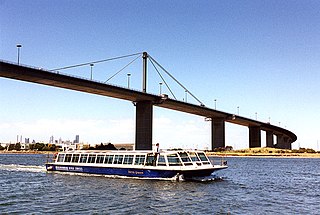
The West Gate Bridge is a steel, box girder, cable-stayed bridge in Melbourne, Victoria, Australia, spanning the Yarra River just north of its mouth into Port Phillip. It carries the West Gate Freeway and is a vital link between the Melbourne central business district (CBD) and western suburbs, with the industrial suburbs in the west, and with the city of Geelong 80 kilometres (50 mi) to the south-west. It is part of one of the busiest road corridors in Australia. The high span bridge was built to allow large cargo ships to access the docks in the Yarra River.
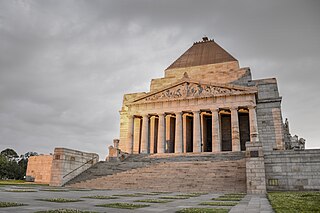
The Shrine of Remembrance is a war memorial in Melbourne, Victoria, Australia, located in Kings Domain on St Kilda Road. It was built to honour the men and women of Victoria who served in World War I, but now functions as a memorial to all Australians who have served in any war. It is a site of annual observances for Anzac Day and Remembrance Day, and is one of the largest war memorials in Australia.

The Parliament of Victoria is the bicameral legislature of the Australian state of Victoria that follows a Westminster-derived parliamentary system. It consists of the King, represented by the Governor of Victoria, the Legislative Assembly and the Legislative Council. It has a fused executive drawn from members of both chambers. The parliament meets at Parliament House in the state capital Melbourne. The current Parliament was elected on 26 November 2022, sworn in on 20 December 2022 and is the 60th parliament in Victoria.
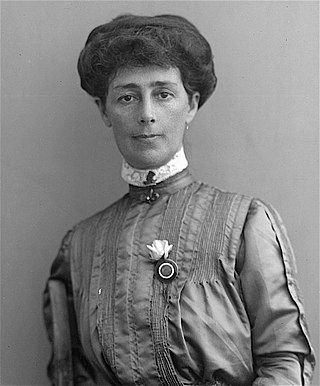
Vida Jane Mary Goldstein was an Australian suffragist and social reformer. She was one of four female candidates at the 1903 federal election, the first at which women were eligible to stand.
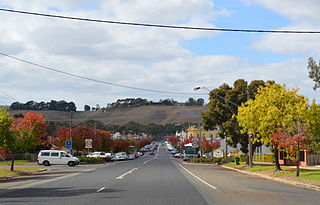
Casterton is a town in Victoria, Australia, located on the Glenelg Highway, 42 kilometres east of the South Australian border, in the Shire of Glenelg. The Glenelg River passes through the town. Casterton is named after the village of Casterton in south-east Cumbria in England.
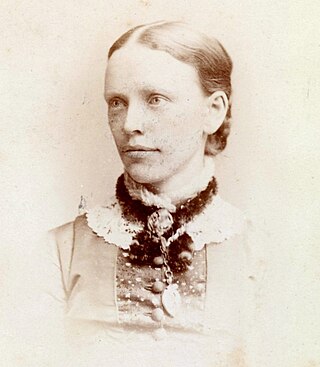
Margaret McLean was a Scottish Australian temperance and women's rights advocate.

Sir Edgar Bertram Mackennal, usually known as Bertram Mackennal, was an Australian sculptor and medallist, most famous for designing the coinage and stamps bearing the likeness of George V. He signed his work "BM".
Australian non-residential architectural styles are a set of Australian architectural styles that apply to buildings used for purposes other than residence and have been around only since the first colonial government buildings of early European settlement of Australia in 1788.

Edwin Walter "Teddy" Rankin was an Australian rules footballer, originally with Riversdale, who began playing with Geelong in the VFA in 1891, and later played in the Victorian Football League (VFL).

Women's suffrage in Australia was one of the early achievements of Australian democracy. Following the progressive establishment of male suffrage in the Australian colonies from the 1840s to the 1890s, an organised push for women's enfranchisement gathered momentum from the 1880s, and began to be legislated from the 1890s, decades in advance of Europe and North America. South Australian women achieved the right to vote in 1894, and to stand for office in 1895 following the world first Constitutional Amendment Act 1894. This preceded even male suffrage in Tasmania. Western Australia granted women the right to vote from 1899, although with some racial restrictions. In 1902, the newly established Australian Parliament passed the Commonwealth Franchise Act 1902, which set a uniform law enabling women to vote at federal elections and to stand for the federal parliament. By 1908, the remaining Australian states had legislated for women's suffrage for state elections. Grace Benny was elected as the first councillor in 1919, Edith Cowan the first state Parliamentarian in 1921, Dorothy Tangney the first Senator and Enid Lyons the first Member of the House of Representatives in 1943.

Australia's monuments take on many distinct forms, including statues, fountains, natural landmarks and buildings. Whilst some monuments of Australia hold a national significance, many are constructed and maintained by local community groups, and are primarily significant on a local scale. Although Australia's monuments have many roles, including as tourist attractions, their primary purpose is to "safeguard, prolong or preserve social memory into the future". This social memory may relate to anything from colonisation to local industry to sports. The monuments of Australia reflect the nation's social and political history and by memorialising select moments, contribute to shaping how Australian history is told. Although a significant portion of Australia is desert, the population is highly urbanised and the cities contain some noteworthy monuments.
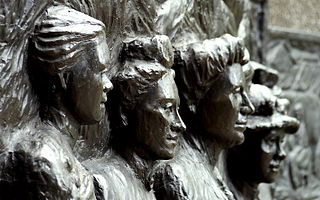
The Kate Sheppard National Memorial, located in the city of Christchurch, is New Zealand's first memorial to the women's suffrage campaign, and particularly honours the life of one of the country's leading campaigners for women's suffrage, Kate Sheppard.
The Centenary of Women's Suffrage Fountain is located in the grounds of Old Parliament House in Canberra, Australian Capital Territory, Australia. It commemorates the passing of the Commonwealth Franchise Act 1902, which granted the right to vote to white Australian women over 21 years of age.

Resilience is a sculpture located in Brisbane, Queensland, Australia. It honours the efforts of Queensland's men and women who worked to achieve women's suffrage in the state.
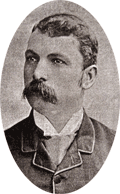
Frederick William Commons (1860-1925) was an Australian monumental sculptor who was commissioned to carve the monuments in the Ballarat Town Hall. He was commissioned to carve four allegorical figures for Parliament House, Melbourne, each 12 ft high and for £2,100. However, it never eventuated due to the depression. Today, many of his works can be seen in statues and monuments in the Ballarat district.
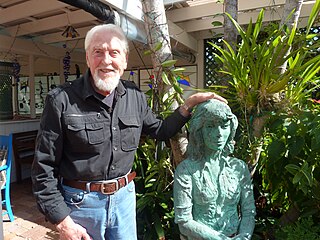
Marc Clark was a British-born Australian academic, sculptor and printmaker.

Isabella Goldstein lived in Victoria, Australia, was an Australian suffragist and social reformer, one of the organisers of the Women's Suffrage Petition to the Victorian state parliament and the mother of Vida Goldstein.

Maria (Marie) Elizabeth Kirk born Maria Elizabeth Sutton was a British-born Australian temperance advocate and social reformer. She was involved in women's rights including organising a "monster" petition for women's suffrage in 1891.


















